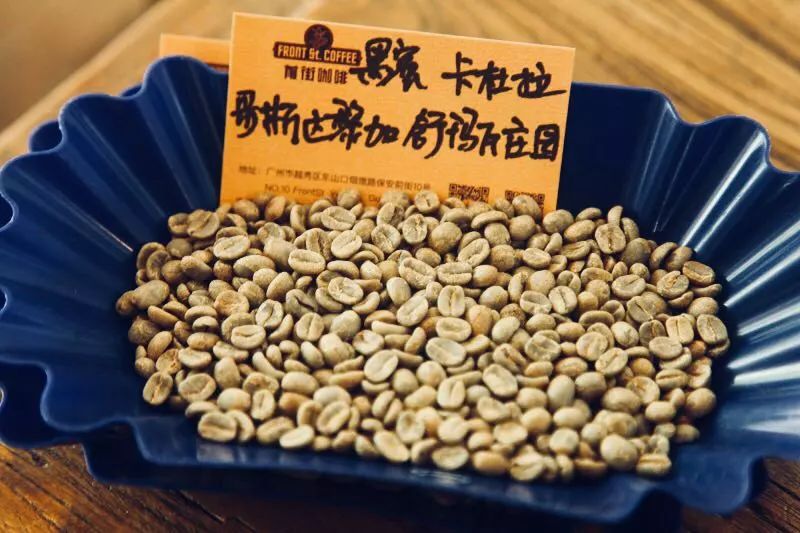How does the taste change after coffee bean honey treatment? What kind of coffee is coffee bean honey processing suitable for brewing?

Professional coffee knowledge exchange More coffee bean information Please pay attention to coffee workshop (Weixin Official Accounts cafe_style)
Have you ever wondered what coffee honey treatment is?
Does honey-treated coffee taste better than coffee you've previously drunk treated with other methods?
The following article will guide you through what is honey processing? What are the characteristics of honey treatment?…
Why is Honey Called Honey?
Why honey?
There are three main types of coffee treatment: sun, water, honey treatment.
Sunlight method is to directly expose coffee fruit before removing shell and pectin layer; washing method is to soak and soften (ferment) peel and pulp of coffee fruit with a large amount of flowing water, and then carry out sun drying and screening; honey treatment method is between sunlight method and water washing method, peel coffee fruit, keep pulp (pectin) layer for sun exposure.
So, wait, where's the honey?
So you might ask, where's the honey?
The term honey treatment may lead many people to think that this treatment is treating coffee with honey, or that this treatment makes coffee taste sweet as honey, but in fact it is not the correct connection or explanation. Honey treatment means that the pulp (pectin) layer of the coffee fruit feels sticky and honey-like when exposed to sunlight. That is, when the coffee fruit is peeled off, the pectin layer coated on the periphery is exposed to the sun, absorbing moisture from the air to make the pectin layer sticky, as if wrapped in honey.
honey exposure condition
Why is Honey Processing Popular Among Farmers?
Why is honey processing popular with coffee farmers?
Honey processing started in Costa Rica when some people saw that it could keep their coffee beans up, and it's now getting stronger.
So why did Costa Rican coffee farmers plan to treat it with honey in the first place?
When coffee farmers want to increase the quality or price of their coffee, they have three options: change the species of coffee, change the elevation at which they grow it, or change the treatment. Just as most people brew coffee in a simpler way, adjusting the grind and powder levels before adjusting the water, pressure and temperature of the coffee machine, most coffee farmers want to change the treatment before considering planting new trees or relocating their farms, which requires more time and money.
So what's involved with honey processing?
What are the steps involved in honey processing?
Honey treatment method can not be simple, both time-consuming and pay attention to processing details.
First, coffee farmers pick ripe coffee cherries from coffee trees and peel them off the outer peel, leaving the pectin layer. The pectin layer retains a high proportion of sugars and acids, which are key to honey processing.
The next step is the most complex and delicate part of honey treatment: exposure.
The time point must be well mastered, the length of time is the key, if the exposure time is too short, the pectin layer cannot be converted into coffee beans, and the time cannot be too long, the action must be fast to avoid excessive fermentation inside the beans and become moldy beans.
So how do you strike a balance?
For the first few days after placing the beans on a sun rack or concrete floor, turn the beans several times per hour until the desired moisture content is reached, a step that usually takes 6-10 hours. After 6-8 days, turn at least once a day. Time consuming, huh? The reason why the honey-treated sun is so time-consuming is that each night the beans absorb moisture from the air, so that they need to spend more time in the sun the next day.
When the coffee has been exposed to the sun, it can be dried and roasted just like any other treatment.
Honey treatment, sun exposure. jpg
Why is Honey Processing So Wonderful?
Why is honey processing so good?
When honey processing is so difficult and time-consuming, you might wonder if it's really worth it.
No doubt it was worth it.
Honey-treated coffee generally has a great sweetness and balanced acidity. The flavor is not as strong as sun-dried coffee, but it is fresher and more mellow. Why not?
The key to this flavor difference comes from the sugars and acids in the pectin layer, which become more concentrated during exposure and penetrate into the beans.
Yellow, Red, and Black Honey: What’s The Difference?
What is the difference between yellow honey, red honey and black honey?
When you buy honey-treated coffee, you usually have yellow, red, or black honey to choose from. You may have heard about how much of the pulp (pectin) layer is retained in each of these honey treatments, and what does that mean?
Coffee farmers treat coffee in different layers, some retaining less pulp (pectin) layer, which reduces exposure time; others retaining more pulp (pectin) layer, which requires longer exposure time. Yellow honey (approximately 25% pectin layer retained) must be carried out in an environment with minimal shade (clouds, shade trees) to achieve a yellow appearance in order to complete the process faster. Red honey (approximately 50% pectin layer retained) takes longer and requires some shade to expose. Black honey (which retains about 100% of the pectin layer) naturally requires longer exposure times, and is usually covered during the process to extend the exposure time.
Honey treatment, from right to left black, red, yellow…jpg
Yellow, Red, & Black Honey: Which Is Better?
Yellow honey, red honey, black honey, which is better?
It may be that black honey is better. The flavor of honey treatment will bring more delicate influence because of the sugar contained in the pectin layer. The more pectin layer is retained, the stronger the flavor is. (Note: This is the original author's point of view, Xiaobian thinks that black honey, red honey, yellow honey and other different processing methods will have different flavor characteristics, which is better? It depends on your taste preferences.)
Qianjie Coffee: Guangzhou's baking shop, small store but a variety of beans, can find a variety of famous beans, but also provide online store services. https://shop104210103.taobao.com
Important Notice :
前街咖啡 FrontStreet Coffee has moved to new addredd:
FrontStreet Coffee Address: 315,Donghua East Road,GuangZhou
Tel:020 38364473
- Prev

What are the ways to dry coffee beans? What is the difference between coffee bean washing and sun marking?
Professional coffee knowledge exchange more coffee bean information Please pay attention to the coffee workshop (Wechat official account cafe_style) when buying coffee beans, we often see the words "Washed", "Natural", or "Honey". These are the ways to treat raw coffee beans, that is, the way they are dried. What exactly does it mean? For coffee.
- Next

What are the flavor and taste characteristics of honey-treated coffee beans? What kind of coffee is suitable for making coffee beans with honey?
Professional coffee knowledge exchange more coffee bean information please follow the coffee workshop (Wechat official account cafe_style) Coffee treatment Honey treatment HoneyProcess Honey treatment, English HoneyProcess or MielProcess, also known as semi-washing
Related
- What is the meaning of lactic acid fermentation with coffee bean treatment?
- How to judge the state of foam by sound?
- How does the latte pull out the unicorn pattern? Come to get for a little trick to improve the flower pull!
- Will flower pulling affect the taste of the latte?
- Do you know the history of coffee?
- The difference between honey treatment and sun washing what is raisin honey treatment?
- What kind of milk can a novice use to make coffee foam to keep the foam longer? The correct method and skills of milking tutorial sharing
- Why do washed coffee beans taste sour? Flavor characteristics of washed Coffee
- Introduction to the skill of how to practice the size and height of water injection around the circle of hand-brewed coffee
- How do beginners practice coffee flower drawing from scratch?

